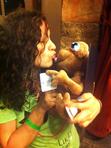Red Harvey's Blog, page 6
May 14, 2012
A SF Literary Study isn't complete without "Critical Theory and Science Fiction". And here's why.
 An idealized version of what the SF genre is (or was).Cover of the fantasy fiction magazine
An idealized version of what the SF genre is (or was).Cover of the fantasy fiction magazineAvon Science Fiction Reader no. 3 (1952)
by Frank Belknap Long Source: Wikimedia Commons A comprehensive (and often) exhaustive study on the validity of science fiction in the literary canon. In fact, author Carl Freedman dedicates an entire section of the book to the description, history, and importance of the literary canon and why science fiction works are to be included in the canon.
Freedman’s text redefines science fiction ‘cognitive estrangement’, as coined by author Darko Suvian. To better understand Suvian’s meaning, a quote is rather necessary: “estrangement ‘differentiates [science fiction] from the realistic literary mainstream’, while cognition differentiates it from myth, the folk tale, and fantasy […] science fiction is determined by the dialectic between estrangement and cognition” (p. 16).
To Freedman, the genre of science fiction is constantly evolving, and it is hard to pinpoint the what exactly constitutes the epitome of science fictional text. Freedman’s views of science fiction are so broad (or maybe so idealized) that he believes all general fiction to be a sub-category of science fiction, and not the other way around (p. 20). The expansive reach of the science fiction genre in Freedman’s eyes is boggling. Freedman believes that every fictional text ever written is a sort of science fictional story as well, because some apt descriptions of science fiction say it is the creation of a new world. Arguably, every fictional novel is a ‘new world’ created by the author and the characters that populate it.
In three not-so-short chapters, Freedman takes the reader on a new expedition into the academic world of science fiction. Chapter one is titled “Definitions”, and it does just that; chapter one defines critical theory and science fiction, melding the two together with Freedman’s conclusions (juxtaposed with other academic opinion of course). Chapter Two, “Articulations”, first discusses genre, literary canon, and theory. Then, science fiction is measured against three critical dynamics: style, the historical novel, and utopia. Chapter three, “Excursuses”, give detailed overviews of Solaris, The Dispossessed, The Two of Them, Stars in My Pocket, and The Man in the High Castle.
Lastly, Freedman includes a section that explores critical theory and science fiction and how it may later evolve, as Freedman concedes that “it is in the nature of critical fiction and science fiction to speculate about the future” (p. 181).
Freedman’s section on utopias and feminism make a nice addition to the academic conversation. In that same section, authors Ursula Le Guin and Joanna Russ are compared and contrasted in a very satirical manner: “The basic contrast frequently adduced is between the gentleness of Le Guin’s feminism and the angry militancy of Russ’s” (p. 129). Freedman makes fun of such comparisons, stating that they are responsible for creating further rifts for women in science fiction (or in society in general). He also muses on the fact that for early pulp science fiction of the 1900’s, it was hard for the genre to recognize able-bodied women, or admit the fallacy of phallic dominance (p. 129).
Throughout the book, Freedman’s tone is one that strives to reach the reader, but always falls a little bit short with a myriad of unknown adjectives and a mountain of footnotes on almost every page (even though in the preface Freedman expresses his own dislike of footnotes, on the grounds that it is a ‘pseudoscholarly practice of citing works in order to suggest, truthfully or not, that one has read them’ [p. xx]). Despite that, once the reader is able to follow Freedman’s ideas and take hold of them, his tone is quite suggestive, humorous, and down-to-earth.
Critical Theory and Science Fiction was published in 2000. That fact only becomes evident in the last section which mentions the evolutionary pattern that will take hold of science fiction, namely, cyberpunk. To an extent, Freedman is correct, so it is a forgivable error in his effort to create a timeless account of the science fiction genre. Since his studies in the book mention books in the literary canon from 1818 until the late 1980’s, the year of publication is nominal in this instance.
Generally, I prefer not to read academic texts unless they are strictly related to what I am studying. Freedman’s book was one that did not let me forget what I was studying, and it was an academic text that I highlighted like a lunatic, madly muttering to myself things like “yes….and yes…” and “of course!”. If future readers can get over the flowery detailed language in the preface, then they will count themselves lucky to have stumbled upon the fascinating overviews provided by Freedman in his three, seventy-five-page chapters.
Freedman is an associate professor of English at Louisiana State University. He is the author of several articles and four non-fiction texts. An excerpt from his book Critical Theory and Science Fiction was chosen as featured text for discussion at the Theory Roundtable of the International Conference on the Fantastic in the Arts in 2002.
Freedman, Carl. Critical Theory and Science Fiction. Middletown, Connecticut: Weslayen University Press, 2000. Print.
Published on May 14, 2012 19:56
Themes in Mary Shelley's "Frankenstein"
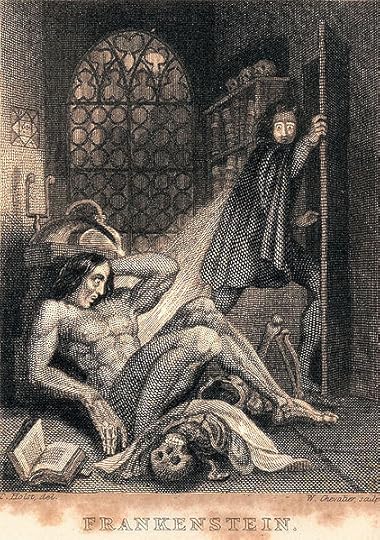 Frontpiece to Mary Shelley's "Frankenstein"
Frontpiece to Mary Shelley's "Frankenstein"(1831)
By Theodor Von Holst
Source: Wikimedia CommonsVictor Frankenstein is a privileged, intelligent young man from Ingolstadt who is passionate about life and the mysteries of creation. Fueled by this passion, he creates a sentient being. The drawback of Victor’s creation is its visage; the creature is more hideous than any other living thing on Earth, and all who look upon it instinctually draw back in fear.
Loved by no one (especially not Victor), the creature flees to the woods of Germany. There, he becomes literate in both words and love. Though, when he approaches the humans whom he cares most about, they react with predictable horror upon seeing his hideous form. Abandonment and fear are the two constants in the creature’s life. Those two things shape the creature into a demon, one that wishes to visit agony upon his creator by murdering everyone Victor holds dear.
Major themes in this book include humanity’s ever-expanding reach in creating something greater than human. However, as Victor learns, once such a being is created, it cannot be undone as easily as it was put together. There are consequences to creating a creature with human parts, but lacking any other qualities of a human (emotions, sympathies, intelligence). Even when the creature acquires these other human traits, it doesn't make him human in the eyes of others (though he felt himself to be equal to humans).
Another theme in the book is man’s inability to accept that in which he does not understand. Immediately, those who behold the creature spot him as a demon, without even allowing him to speak or act. Even when the creature acts solicitously (replenishing food and firewood, saving a woman from drowning), his actions go unappreciated and are even met with brutal force. Of his personality forming the way it did, the creature says “I cannot believe that I am the same creature whose thoughts were once filled with […] visions of […] goodness. But it is even so; the fallen angel becomes a malignant devil. Yet, even that enemy of God and man had friends […]. I am alone.” (Shelley, p. 124). In a large way, the creature's creator and the world around him are responsible in creating a humanoid monster.
Shelley, Wollstonecraft, Mary. Frankenstein. London: Lackington, Hughes, Harding, Mavor & Jones, 1818. Print.
Published on May 14, 2012 08:00
May 9, 2012
Promising new author: Elizabeth Baxter
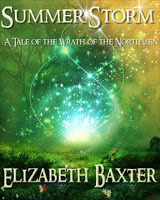
 British author Elizabeth Baxter of the new short story collection Circle Spinner is worth taking note of. She has been writing since she was six years old, and Circle Spinner is her debut novel. She has two more novels coming out this summer: Summer Storm and Everwinter.
British author Elizabeth Baxter of the new short story collection Circle Spinner is worth taking note of. She has been writing since she was six years old, and Circle Spinner is her debut novel. She has two more novels coming out this summer: Summer Storm and Everwinter.Synopsis for Circle Spinner:
 Circle Spinner and Other Tales by Elizabeth Baxter
Circle Spinner and Other Tales by Elizabeth Baxter Five fantasy and science fiction stories that will sweep you to other worlds.
Circle Spinner
Edith longs for a quiet retirement. She longs for her cottage by the sea and the company of her dogs. But the world, it seems, hasn’t done with her yet. For Edith is a Circle Spinner, the only one who can save the city of Shine from the terrifying Pantheon. 6000 words
The Following Star
Angus walks the corridors of a starship with only his dog for company. He guards a precious cargo: a population of colonists searching for a new home. But when a sudden course change threatens the ship, Angus discovers that all is not as it seems. 6000 words
One of those Days
Simon is a high-flyer. Good job. Nice apartment. It’s not his fault if his company is involved in shady dealings with the fairy realm is it? No, if he keeps his head down and mouth shut, Simon is sure everything will be okay. But the Prince of Fae and his motley band of followers have other ideas. They have Simon in mind for a very special mission. 7000 words
The Blessing of Silence
The game has been played for years uncounted. Sakara has watched players come and go and been powerless to save them. She is a slave. What difference could she possibly make? But when a new player suddenly enters the game, Sakara begins to realize that she holds within her the power to end the game forever. 6000 words
Fallen Angel
Matthew’s faith is unshakable. A soldier in the United Church, he has dedicated his life to hunting demons. But when his latest mission goes wrong he discovers a secret that will cast everything he believes into doubt. 6000 words
Reviews for Circle Spinner from Amazon:
"This was the first book I got on my new kindle. I didn't want to go straight into a novel because I wasn't sure if I'd like reading off a screen so I went for something shorter first. It was a good move because I really enjoyed the collection and the kindle didn't hurt my eyes after all. My main problem with short stories is that you don't have enough time to get to know the characters but this wasn't an issue here. You get to know all the characters really well and I found myself rooting for them. I liked some stories better than others, and my favorite was probably The Following Star as I loved Dog. I think there's probably something for everyone in this"
"I enjoyed each of the stories as each provided me with a different emotion and sub-genre: danger, sadness, happiness, comedy and action. The titular story was a great start to the collection: great characters from tired Edith to the evil demon Tenoquitil. I loved the relationship between Angus and dog in the Following Star and really enjoyed the humour in One of Those Days. As I intimated before, the collection provides something for different readers. Summer Storm, although of the fantasy genre (as apposed to sci-fi) proved to be an interesting introduction to what promises to be an exciting story. Overall, an easy to read and well written collection."
Baxter has a web blog that she uses to promote her writing, but the added wonder of her blog is that she also uses it to review and promote indie authors. Check out her blog here: http://elizabethbaxter.blogspot.com/
You can purchase Circle Spinner from this Amazon link, or find it via Baxter's webpage. Look for her on Goodreads as well!
Published on May 09, 2012 08:47
May 7, 2012
Winners and questions from the book giveaway
There were a good number of responses and questions to the giveaway via email. It was hard to pick a few questions to respond to, but I chose the top three questions to share:
1. sammay62951@yahoo.com asked:
What inspired your second book, The Mutant Star Tragedy?
Inspiration for what I'm writing comes from a place I'm not exactly familiar with. Sometimes a dream or a memory will make a story stick in my mind until I get it down on paper. Often, I will have a recurring dream and it won't stop until I begin writing a story around it. Other times, the idea is just there. This particular story came about after I woke up from a nightmare. In my nightmare, a couple had escaped from a madman's basement only to find the world outside had gone and changed on them. From that, I built The Mutant Star Tragedy.
2. cb.grove230@gmail.com asked:
Who supports and inspires you to write?
A big part of my inspiration comes from what I explained above. As for support, my family is it. My husband Sean gave me the idea to take the story of The Mutant Star Tragedy further, and without him, I would have never written parts two and three.
3. sharon_1980@comast.net asked:
What work can we expect from you next?
My current project is a science fiction novel set in a dystopian future. It features a female protagonist with the power to manipulate electric currents. Not only can she re-program any machine she wants, but she discovers that she can re-program human beings as well. Novice use of her newly acquired abilities causes the death of her husband. She is unable to admit her part in the accidental death, and begins a journey for revenge against a father she's never met (as she blames her father for passing the power on to her genetically, and for a few other things).
The first two questioners are also the two winners thanks to random selection (putting emails into a bowl and pulling them out. I know; practically scientific). Thanks to everyone who participated!
1. sammay62951@yahoo.com asked:
What inspired your second book, The Mutant Star Tragedy?
Inspiration for what I'm writing comes from a place I'm not exactly familiar with. Sometimes a dream or a memory will make a story stick in my mind until I get it down on paper. Often, I will have a recurring dream and it won't stop until I begin writing a story around it. Other times, the idea is just there. This particular story came about after I woke up from a nightmare. In my nightmare, a couple had escaped from a madman's basement only to find the world outside had gone and changed on them. From that, I built The Mutant Star Tragedy.
2. cb.grove230@gmail.com asked:
Who supports and inspires you to write?
A big part of my inspiration comes from what I explained above. As for support, my family is it. My husband Sean gave me the idea to take the story of The Mutant Star Tragedy further, and without him, I would have never written parts two and three.
3. sharon_1980@comast.net asked:
What work can we expect from you next?
My current project is a science fiction novel set in a dystopian future. It features a female protagonist with the power to manipulate electric currents. Not only can she re-program any machine she wants, but she discovers that she can re-program human beings as well. Novice use of her newly acquired abilities causes the death of her husband. She is unable to admit her part in the accidental death, and begins a journey for revenge against a father she's never met (as she blames her father for passing the power on to her genetically, and for a few other things).
The first two questioners are also the two winners thanks to random selection (putting emails into a bowl and pulling them out. I know; practically scientific). Thanks to everyone who participated!
Published on May 07, 2012 17:25
April 27, 2012
Free Book Giveaway!
From April 28th until May 6th, I will be hosting a free book giveaway. One copy of each of my novels will be given away to random participants.


To participate, simply post a question about either of the books, such as character bios, inspirations, or anything you would like to know about my little corner of the writing world. When submitting your questions, please attach your name and email so that I may contact you in the event you are the winner. Post your question by emailing me at redharveysworld@yahoo.com, commenting via my facebook page, or commenting on this blogpost. At the end of the giveaway, I will post the most interesting questions I received, along with the answers. Thanks all, and good luck!


To participate, simply post a question about either of the books, such as character bios, inspirations, or anything you would like to know about my little corner of the writing world. When submitting your questions, please attach your name and email so that I may contact you in the event you are the winner. Post your question by emailing me at redharveysworld@yahoo.com, commenting via my facebook page, or commenting on this blogpost. At the end of the giveaway, I will post the most interesting questions I received, along with the answers. Thanks all, and good luck!
Published on April 27, 2012 19:16
April 23, 2012
"The Mutant Star Tragedy" now available as e-book and paperback
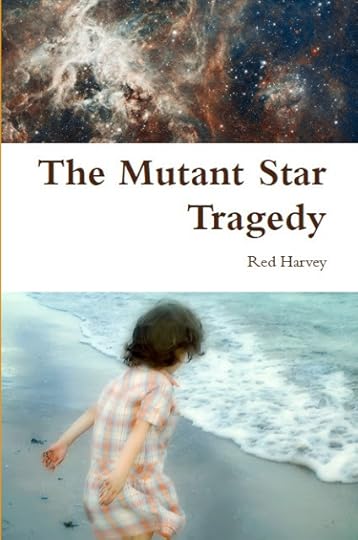
FREE FOR DOWNLOAD ON SMASHWORDS.COM ALL THIS WEEK, ALONG WITH BECOMING, AND THE TALE OF LAMASHTU
Being in a world surrounded by vagrants, vigilantes, and demons would be a lot like living in Hell. Though, the outside world matters little to a boy being held in a murderer's basement.
An unnamed 12 year old boy serves as the narrator to Part One. He and other survivors are the prisoners of a deranged policeman that the boy refers to as 'The Man'. The Man gives the boy a stack of notebooks that he uses to record his experiences in the basement. His experiences involve torture, and the murder of his parents. Ashley Heard is a school-crush the boy mentions. He wonders if she survived the new world...
Ashley witnesses her father's murder at the hands of home invaders. Along her journey to flee a city overrun by otherworldly creatures, Ashley meets Juniper.
Though she is a call girl, Juniper Jones is a very special woman. She has the power of empathy; she can feel what others are feeling on an unnatural level. Her ability makes her very good at her job, but it also comes in handy as a survival tool.
Available for purchase on Amazon, Createspace, Lulu, and Smashwords. Amazon:
http://www.amazon.com/The-Mutant-Star-Tragedy-ebook/dp/B007WUIEBI/ref=sr_1_1?ie=UTF8&qid=1335235187&sr=8-1
Lulu:
http://www.lulu.com/shop/red-harvey/the-mutant-star-tragedy/paperback/product-20079529.html
Smashwords:
https://www.smashwords.com/books/view/155096
Files are still pending on Createspace, but they will be available soon.
Published on April 23, 2012 12:43
April 17, 2012
Overview of Sci-Fi short Story, "The Machine Stops"
 "The Machine Stops"
"The Machine Stops"Source: TheMachineStopsFilm.wordpress.comIn this futuristic short story by E.M. Forster, humanity no longer resides on the surface of the Earth, but far below. The air above is unable to sustain life (or so everyone is led to believe). Human action, need, and desire are guided by the Machine: a super computer that caters to a person’s every wish. Need a hot bath? There’s a button for that. Need to give a lecture about Australian music? There’s a button for that. Sameness is like a disease that has spread across civilization. Every room in every part of the underground Earth looks the same, everyone speaks the same language and feels the same sort of god-like worship for the Machine. The goal of the people is to eventually ‘be free from the taint of personality; live colorlessly’. Living underground requires certain characteristics, so those babies that are born with athletic traits are euthanized, as an athletic person would never be content with a life of solitary confinement. When people want to visit, they do so via cinamotrophes (3-D images of each other, like video chat). To see someone physically over a great distance, people travel by air-ships. The thought of touching one another or seeing daylight is abhorrent. Vashti is a conformist, of the highest degree. However, her son, Kuno, has discovered that humanity has lost touch with each other, and with Nature. He visits the surface (without permission from the machine), and supposedly encounters others. Vashti is embarrassed that her son would go against the Machine, and both of them know that his actions will mean his eviction from his room underground (meaning, he will be forced to live above-ground, which will kill him). Kuno does not care that he will be Homeless. He is passionate about what he experienced on the surface: “"Cannot you see, cannot all you lecturers see, that it is we that are dying, and that down here the only thing that really lives in the Machine? We created the Machine, to do our will, but we cannot make it do our will now. It was robbed us of the sense of space and of the sense of touch, it has blurred every human relation and narrowed down love to a carnal act, it has paralyzed our bodies and our wills, and now it compels us to worship it.”After Kuno’s unscheduled visit to the Earth’s surface is made known to others, above-ground visits are made illegal. Another change is the re-instatement of religion (before it was thought to be perverse to be spiritual in any capacity). The religion that forms is based around the love of the Machine, and its all powerful knowledge and applications. Themes in this story are plentiful. To begin with, man has lost touch with being an individual. The idea of conformity is one of comfort and pleasure. To be different is dangerous and unheard of. Another theme is man’s acquiescence to technology and the risks and rewards behind that. Technology in the story serves man’s every need so that the people begin to pray to it, considering it a divine being (though they acknowledge time and time again that it is a man-made structure). Is it right to worship something simply because it provides for you, even if it is clothing you, feeding you, keeping you safe? Do those conditions create the need for a spiritual connection?There is an theme in the story that really resonated with me, and that is man’s ignorance to the past. People perpetuate traditions, habits, and cultural norms without knowing why (often without caring why. The narrator states “Humanity, in its desire for comfort, had over-reached itself. It had exploited the riches of nature too far. Quietly and complacently, it was sinking into decadence, and progress had come to mean the progress of the Machine.”Once the Machine stops, society breaks almost instantly. People are used to being taken care of, and they do not know how to exist without the thrum of the Machine, and all that it provides for them. As humans equally dependant on technology, I wonder how quietly (or loudly) we would fade after our Machines stopped.
Published on April 17, 2012 18:58
February 28, 2012
Terms in Narratology
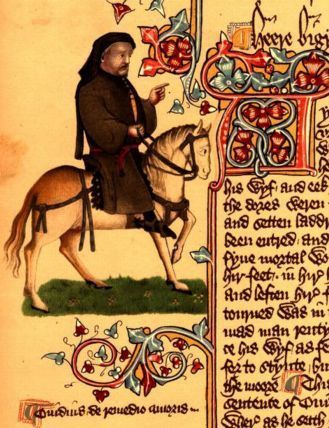 Chaucer as a pilgrim from
Chaucer as a pilgrim from Ellesmere Manuscript,
Early Edition of "The Canterbury Tales"
Source: Wikimedia Commons
Peter Barry describes the terms involved in the study of narratology. Narratology is comprised of many elements culminating in great storytelling, some of which both Dante and Chaucer use in The Miller’s Tale and Vita Nuova.For example, Barry writes about the use of time in a story. Every story has a beginning, middle, and end, but, as Barry puts it, “stories tend to begin in the middle,” (235). That is not to say that stories to not have flash-backs, or even fast-forwards, but to begin at the true beginning of a story can be (at times) boring. The literary term for flash-back is analeptic, with a flash-forward being proleptic. Geoffry Chaucer’s The Miller’s Tale seems to begin in the middle; a drunken miller begins to tell the story of the jealous carpenter and his wife. The reader only knows this because the narrator sets up the backstory first, in analeptic fashion.In the same way, the basic narrative mode of The Miller’s Tale is both diegetic and mimetic. Diegetic is when part of the story is summarized in a few sentences, while mimetic is the opposite. Mimetic storytelling is full of detail and conversation. The beginning of Vita Nuova is most certainly mimetic because of the detail in which the narrator describes the meeting of his love, Beatrice: “She appeared dressed in noblest colour, restrained and pure, in crimson, tied and adorned in the style that then suited her very tender age,” (Dante 5). Section 2 of Vita Nuova is proleptic because the narrator fast-forwards nine years later after meeting the girl of his dreams.Works CitedBarry, Peter. Beginning Theory. England: Manchester University Press. 2009. Print.Alighier, Dante. Vita Nuova. 1295. Web.
Published on February 28, 2012 17:26
January 27, 2012
An Analysis of Zora Neale Hurston's short story "Sweat"
 Zora Neale Hurston-
Zora Neale Hurston-American Author (1935)
By: Author unknown
Source: Wikimedia Commons
Hurston's story "Sweat" depicts an abusive and selfish husband, Sykes. Deliah, Sykes wife, has taken physical, emotional, and verbal abuse from Sykes for more than 15 years. Sykes treats his wife as a petulant teenager treats his mother: with little respect, but still expecting to be fully taken care of. Certainly, Sykes has some sort of mother-complex, even preferring big women to the skinny Deliah. Though his mistress is described in an unflattering light ("a hunk uh liver wid hair on it"), it could be that Sykes finds bigger women attractive because he associates soft curves with a maternal figure.
Sykes is financially dependent upon his wife (since all he does with his own wages is gamble) and that makes him angry, angry enough to want to punish Deliah, and even kill her. Though Deliah's situation is not a happy one, it is not a rare one either. Any man is capable of the darkness found in Sykes. During the story, the other men in town describe the sort of man they believe Sykes to be: "There's plenty men dat takes a wife lak dey do a joint uh sugar-cane. It's round, juicy an' sweet when dey gits it. But dey squeeze an' grind, squeeze an' grind an' wring tell dey wring every drop uh pleasure dat's in 'em out. When dey's satisfied dat dey is wrung dry, dey treats 'em jes lak dey do a cane-chew. Dey throws em away." Many men, whether they are black, white, Asian or Hispanic, can treat women just as Sykes treats Deliah.
All the same, Deliah does seem stuck in her situation because of her race. The men in town gossip about Deliah and Sykes, fully aware of how he has beat her for their entire marriage. Not one of the gossipers mentions aiding Deliah, or calling the police on her behalf. The one thing that works as a temporary deterrent against Sykes is when Deliah threatens to call "the white folks" on him. Would Deliah have felt as helpless against an abusive husband had her character been white? I think so. Any woman who takes physical abuse for fifteen years might feel as though she had no other option but to take the abuse for the remainder of her marriage.
Published on January 27, 2012 12:54
January 20, 2012
How Pound and Eliot Changed Modernist Poetry
 "Leathad na Cròice"
"Leathad na Cròice"By Richard Webb (2006).
Source: Wikimedia Commons
Poems like "Hugh Selwyn Mauberly" and "The Wasteland" seem to embody the standard of Modernist poetry. Other Modernist poets like Moore, Millay, and Williams share the aesthetic element of Modernism, which is to allow each line of prose to fall naturally and playfully. However, the sensibility of most Modernist poetry hardly feels playful; poems by Pound and Eliot seem to share their dark perspectives on the world, their thoughts on existentialism, and other feelings through the use of their own experiences and memories.
Eliot uses the first person perspective heavily in his poems, such as "I have", "I read", or "I will show" in "The Wasteland". For example, these lines from "The Wasteland" can be interpreted as a memory or experience of Eliot's because of the way they are presented to the reader:
"My cousin’s, he took me out on a sled,
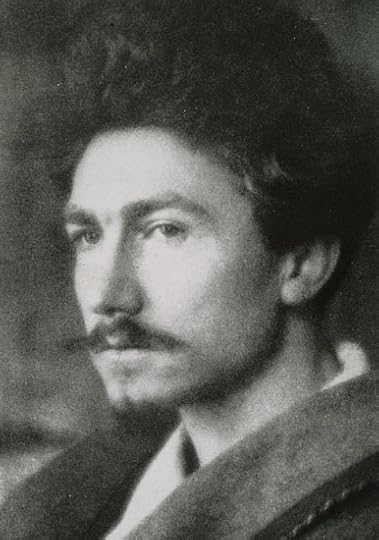 "Ezra Pound"
"Ezra Pound"By Alvin Langdon Coburn
(1913)
Source: Wikimedia CommonsThough he does not use the same first person perspective as Eliot, Pound also seems to reflect on his own life in "Hugh Selwyn Mauberly" when he writes:
"For three years, out of key with his time,Of poetry; to maintain "the sublime"
In the old sense. Wrong from the start –"
By basing their poetry from their own thoughts and experiences, Eliot and Pound bring a cultural disparity to their work, as every human can bring their cultural baggage to the table, so to speak. Because of that disparity, the Modernist poems contain a sense of realism that is relatable on a much wider scope.
Published on January 20, 2012 11:10

